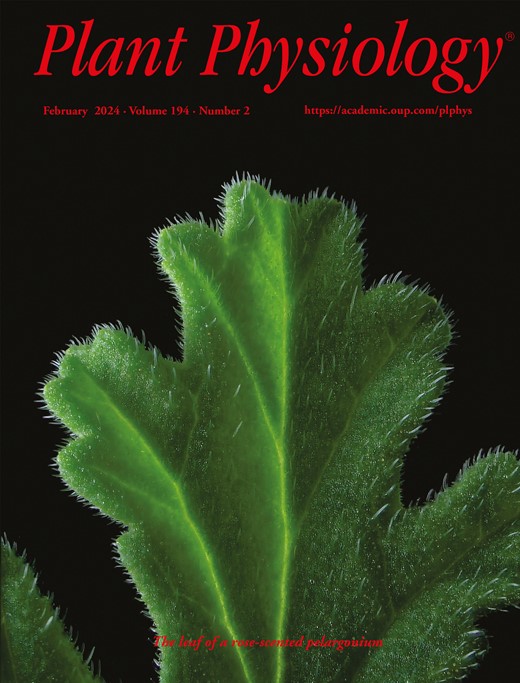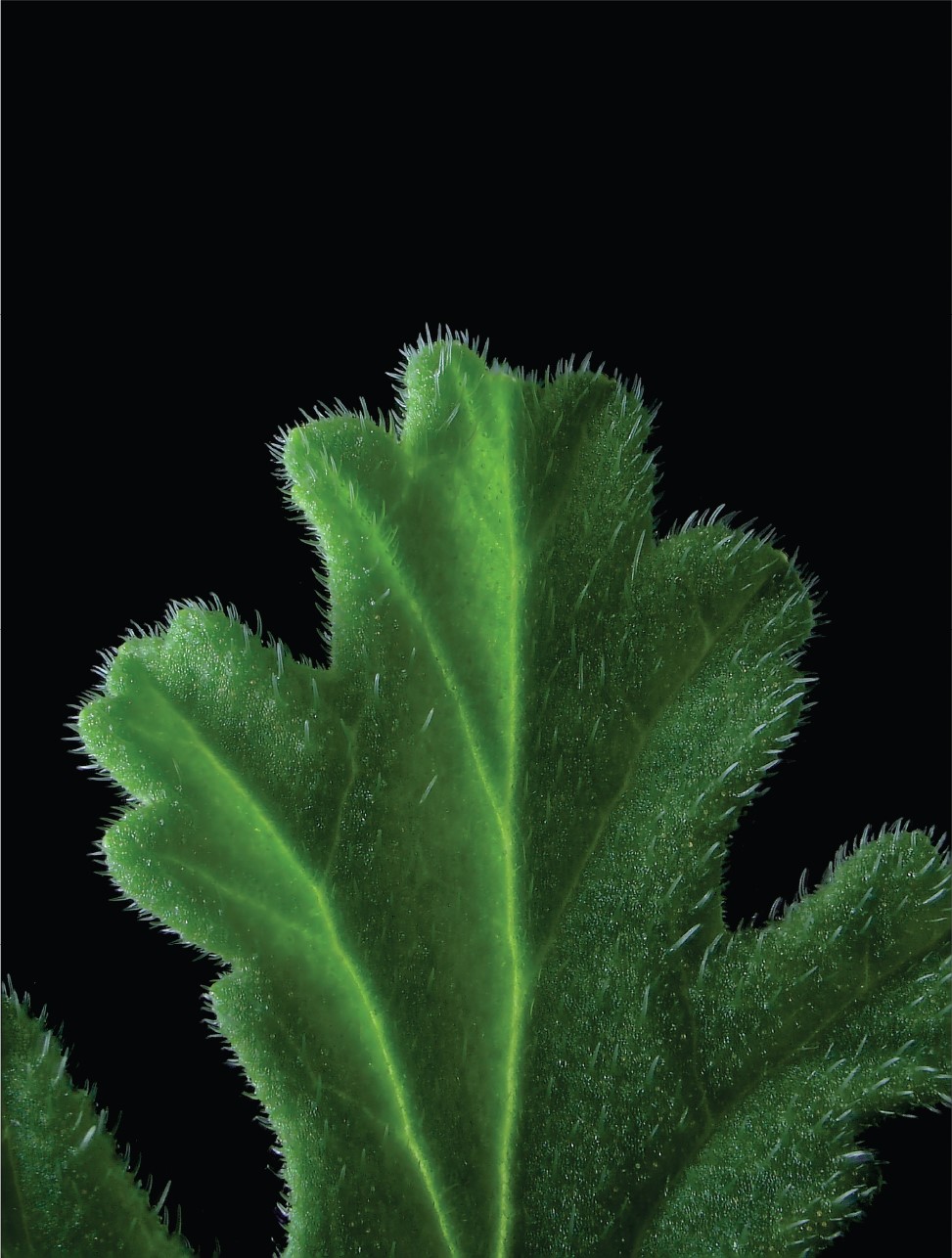
Cover image

Volume 194, Issue 2, February 2024
Editorial
Plant Physiology welcomes 15 new Assistant Features Editors
News and Views
Sense or nonsense? The role of protein acetylation in cyanobacterial photosynthesis and growth
The one that takes it all: The essential role of VDAC3 in the redundant control of ABA signaling
Touch me not! Jasmonic acid and ethylene converge on gibberellins breakdown to regulate touch-induced morphogenesis
An invasion deep into the nucleus: stripe rust effector Pst21674 inhibits transcription factor TaASR3 in wheat
The pollen tube's secret to slick growth? A dab of pectate lyase-like enzyme
Parasitic plants are one step ahead: Cuscuta responds transcriptionally to different hosts
Letter to the Editor
Cellulose biosynthesis inhibitor isoxaben causes nutrient-dependent and tissue-specific Arabidopsis phenotypes
Letter
Activity-directed selection of natural variants of a receptor kinase facilitates salt-tolerant rice breeding
Reduced the kinase activity of SALT INTOLERANCE 1 in a natural variant is better-suited to maintain the balance between growth and salt tolerance in rice.
PLANT UNCOUPLING MITOCHONDRIAL PROTEIN 2 localizes to the Golgi
In contrast to its close homolog PLANT UNCOUPLING MITOCHONDRIAL PROTEIN 1 (UCP1), which is an abundant carrier protein in the mitochondria, UCP2 localizes to the Golgi.
Microtubule-associated proteins MAP65-1 and SUN18/IQD26 coordinately regulate tomato fruit shape by affecting cell division
Microtubule-associated proteins MAP65-1 and SUN18 function additively in fruit shape regulation by modulating cell division patterns but not changing cell morphology.
Research Articles
Biochemistry, Biophysics, and Structural Biology
Deciphering the structure, function, and mechanism of lysine acetyltransferase cGNAT2 in cyanobacteria
The cyanobacterial Gcn5-related N-acetyltransferase regulates the growth and photosynthesis of Synechococcus PCC 7002 through an acetylation-mediated mechanism.
Breakthrough Technologies, Tools and Resources
Fluorescein staining of chloroplast starch granules in living plants
Fluorescein stains chloroplast starch granules in living plant cells and refined starch in vitro by entering the amylose and amylopectin vacancy in a similar way as iodine.
Cell Biology
Distinct ADP-ribosylation factor-GTP exchange factors govern the opposite polarity of 2 receptor kinases
Polarized secretion of a pair of leucine-rich repeat receptor-like kinases is regulated by specific ADP-ribosylation factor-GTP exchange factors, which act independently of polar domain and cell type.
E3 ligases MAC3A and MAC3B ubiquitinate UBIQUITIN-SPECIFIC PROTEASE14 to regulate organ size in Arabidopsis
Analysis of 2 suppressors uncovers the molecular and genetic mechanisms by which E3 ligases MAC3A and MAC3B affect the stability of UBIQUITIN-SPECIFIC PROTEASE14 to control plant organ size.
Conserved cobalamin acquisition protein 1 is essential for vitamin B12 uptake in both Chlamydomonas and Phaeodactylum
Knockout mutants and physiological studies demonstrate that vitamin B12 uptake in both Chlamydomonas reinhardtii and the unrelated Phaeodactylum tricornutum requires cobalamin acquisition protein 1.
Sugarcane mosaic virus employs 6K2 protein to impair ScPIP2;4 transport of H2O2 to facilitate virus infection
Sugarcane mosaic virus employs 6K2 protein to interact with sugarcane aquaporin ScPIP2;4 to impair ScPIP2;4 transport of H2O2, thereby facilitating virus infection.
Ecophysiology and Sustainability
Characterizing the breakpoint of stomatal response to vapor pressure deficit in an angiosperm
Stomata in angiosperms are insensitive to an increase in vapor pressure deficit until leaf water potential drops sufficiently to trigger abscisic acid biosynthesis.
Chronic warming and dry soils limit carbon uptake and growth despite a longer growing season in beech and oak
Hot drought reduce leaf-level carbon uptake and growth despite a longer growing season in beech and oak. However, mixture stands of these species limit their vulnerability to such extreme events.
Genes and Development
Ethylene and jasmonate signaling converge on gibberellin catabolism during thigmomorphogenesis in Arabidopsis
Maize GOLDEN2-LIKE proteins enhance drought tolerance in rice by promoting stomatal closure
Maize GOLDEN2-LIKE proteins confer drought tolerance in rice by promoting abscisic acid–mediated stomatal closure and preventing water loss.
IbMYB73 targets abscisic acid-responsive IbGER5 to regulate root growth and stress tolerance in sweet potato
Transcription factor IbMYB73, acting as a homodimer, activates the transcription of abscisic acid-responsive IbGER5 and inhibits adventitious root growth and abiotic stress tolerance in sweet potato.
PEP-ASSOCIATED PROTEIN 3 regulates rice tiller formation and grain yield by controlling chloroplast biogenesis
PEP-ASSOCIATED PROTEIN 3 regulates chloroplast biogenesis by modulating chloroplast gene transcription and its overexpression in rice improves tiller formation and grain yield.
Age-dependent analysis dissects the stepwise control of auxin-mediated lateral root development in rice
Lateral root number, width and length affect water and nutrient uptake from the soil, and the stepwise development of these features is determined by auxin signaling in a time-dependent manner.
Disruption of p-coumaroyl-CoA:monolignol transferases in rice drastically alters lignin composition
Disrupting p-coumaroyl-CoA:monolignol transferase genes eliminates p-coumarate decorations on lignin with alterations in the core lignin polymer structure in rice cell walls.
early maturity 7 promotes early flowering by controlling the light input into the circadian clock in barley
early maturity 7 controls photoperiodic flowering in barley by modifying the diurnal expression pattern of the major photoperiod response gene Ppd-H1.
Transcription factor CsMYB77 negatively regulates fruit ripening and fruit size in citrus
The transcription factor CsMYB77 negatively regulates fruit ripening and fruit size in citrus by modulating abscisic acid and auxin-signaling pathways.
H2 supplied via ammonia borane stimulates lateral root branching via phytomelatonin signaling
Ammonia borane, a hydrogen storage material used in the energy industry, supplies H2, and stimulates LR branching, showing its potential in horticultural production.
Cryptochrome 1b represses gibberellin signaling to enhance lodging resistance in maize
Maize cryptochrome 1b integrates light pathway with gibberellin metabolic pathway to reduce plant height and to enhance lodging resistance.
Genomics and Evolution
Evolutionary trajectory of organelle-derived nuclear DNAs in the Triticum/Aegilops complex species
Dynamic genetic and epigenetic changes in organelle-derived nuclear DNAs drive intricate genome evolution in the diverse Triticum/Aegilops complex species, shaping their genetic landscape over time.
Membranes, Transport, and Bioenergetics
The role of the pigment–protein complex LHCBM1 in nonphotochemical quenching in Chlamydomonas reinhardtii
In the alga C. reinhardtii, the presence of the pigment–protein complexes LHCSR3 and LHCBM1 is crucial for protecting against excess light, with LHCBM1 potentially enhancing the function of LHCSR3.
Metabolism
Regulation of L-aspartate oxidase contributes to NADP+ biosynthesis in Synechocystis sp. PCC 6803
L-Aspartate oxidase is a regulatory enzyme in NADP+ biosynthesis in the unicellular cyanobacterium Synechocystis sp. PCC 6803.
Acyl-CoA binding protein is required for lipid droplet degradation in the diatom Phaeodactylum tricornutum
CRISPR-Cas9 knock-out of a gene encoding an acyl-CoA binding protein in the diatom Phaeodactylum tricornutum results in alterations to lipid turnover during recovery from nitrogen starvation.
NTRC and thioredoxins m1/m2 underpin the light acclimation of plants on proteome and metabolome levels
NTRC balances the Calvin–Benson cycle in fluctuating light and along with thioredoxins m1/m2 supports the re-engineering of the proteome and metabolome during acclimation to light intensity.
Citronellol biosynthesis in pelargonium is a multistep pathway involving progesterone 5β-reductase and/or iridoid synthase-like enzymes
Molecular biology, bioinformatics, and analytical chemistry techniques reveal how fragrant pelargoniums perfume the air with rose scent.
Allele-dependent expression and functionality of lipid enzyme phospholipid:diacylglycerol acyltransferase affect diatom carbon storage and growth
Allele-encoded phospholipid:diacylglycerol acyltransferase responds specifically to nitrate stress and promotes triacylglycerol accumulation in the model diatom Phaeodactylum tricornutum.
Signaling and Response
Mitochondrial VOLTAGE-DEPENDENT ANION CHANNEL 3 regulates stomatal closure by abscisic acid signaling
Arabidopsis mitochondrial protein VOLTAGE-DEPENDENT ANION CHANNEL 3 regulates abscisic acid–mediated stomatal closure by affecting cellular and mitochondrial accumulation of reactive oxygen species.
PGR5-LIKE PHOTOSYNTHETIC PHENOTYPE1A redox states alleviate photoinhibition during changes in light intensity
Changes in the redox state of crucial cysteines in PROTON GRADIENT REGULATION5-like protein 1A contribute to the control of cyclic electron flow under conditions of fluctuating light.
Transcription factor SlWRKY50 enhances cold tolerance in tomato by activating the jasmonic acid signaling
Transcription factor WRKY50 and jasmonic acid signaling establish a self-amplifying feedback loop to enhance cold tolerance in tomato.
Chloride, glutathiones, and insect-derived elicitors introduced into the xylem trigger electrical signaling
Using a century-old method it is possible to introduce diverse molecules of non-plant origin into the vasculature in intact leaves.
Transcription factor DgMYB recruits H3K4me3 methylase to DgPEROXIDASE to enhance chrysanthemum cold tolerance
The transcription factor DgMYB recruits the histone transferase DgATX to increase the histone level of the peroxidase DgPOD and enhance transcriptional activity, thereby improving cold resistance.
Long noncoding RNA TRABA suppresses β-glucosidase-encoding BGLU24 to promote salt tolerance in cotton
Long noncoding RNA suppresses β-glucosidase-encoding gene promoter activity, and β-glucosidase protein interacts with RING-type E3 ubiquitin ligase protein, coregulating salt tolerance in cotton.
Eggplant transcription factor SmMYB5 integrates jasmonate and light signaling during anthocyanin biosynthesis
Golgi apparatus-localized CATION CALCIUM EXCHANGER4 promotes osmotolerance of Arabidopsis
CATION CALCIUM EXCHANGER4 is a Golgi-localized transporter involved in Ca2+ responses and plays important roles in osmotic tolerance, Ca2+ content in shoots, and Arabidopsis growth.
MdbHLH160 is stabilized via reduced MdBT2-mediated degradation to promote MdSOD1 and MdDREB2A-like expression for apple drought tolerance
The ABA-responsive transcription factor MdbHLH160 enhances apple drought tolerance by promoting MdSOD1 and MdDREB2A-like expression and undergoes MdBT2-mediated ubiquitination and degradation.
Phosphate starvation regulates cellulose synthesis to modify root growth
Phosphate starvation changes root growth by increasing cellulose deposition through alterations in cellulose synthase complex activity and phosphorylation.
Coat protein of cassava common mosaic virus targets RAV1 and RAV2 transcription factors to subvert immunity in cassava
Cassava common mosaic virus coat protein competitively interacts with immunity transcription factors to inhibit transcriptional activation of downstream genes.










































